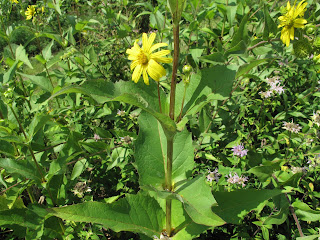Boot Lake Nature Preserve, northwest of Elkhart, IN includes a reconstructed prairie. The web site documents this valuable reconstruction from a former sewage slag dump. Many native prairie plants are now in bloom.
From the parking lot I took the lane past the tree nursery to the prairie, continued on that wide mowed path through the prairie and looped right on "Prairie Pike", right again on "Purple Coneflower Pass" and right a third time to return again to the nursery lane, where I turned left to return to the parking lot.
In late summer there are so many species of wildflowers in the "Sunflower" or "Aster" Family. Even after studying Newcomb's Wildflower Guide (see book review), frequently I am uncertain of the species. Please feel free to enter comments and questions regarding my identification.
 |
| Flowers of Cup-Plant, Silphium perfoliatum |
 |
| Joined opposite leaves of Cup-Plant |
 |
| Prairie Rosinweed, Silphium integrifolium |
 | |
| Prairie Dock, Silphium terebinthinaceum |
 | |
| Compass-Plant, Silphium laciniatum |
 |
| Purple Coneflower, Echinacea purpurea |
 |
| Wild Quinine, Parthenium integrifolium |
 |
| Flowering Spurge, Euphorbia corollata |
 |
| Whorled Milkweed, Asclepias verticillata |
 |
| Wild Bergamot, Monarda fistulosa |
 |
| Canada Tick-Trefoil, Desmodium canadense, Pea Family |
 |
| Blue Vervain, Verbena hastata, Verbena Family |
Common Fleabane Erigeron philadelphicus
Gray-Headed Coneflower Ratibida pinnata
Jerusalem Artichoke Helianthus tuberosa
Field Thistle Cirsium discolor
Lance-Leaved Goldenrod Solidago graminifolia
Common Evening Primrose Oenothera biennis
Narrow-Leaved Mountain Mint Pycnanthemum tenuifolium
Introduced, i.e., not native, plants in flower are -
Spotted Knapweed Centaurea maculosa
Bouncing Bet Saponaria officinalis
Deptford Pink Dianthus armeria
Common Mullein Verbascum thapsus
Queen Anne's Lace Daucus carota
Yellow Sweet Clover Melilotus officinalis
White Sweet Clover Meliotus alba
Red Clover Trifolium pratense
White Clover Trifolium repens

No comments:
Post a Comment